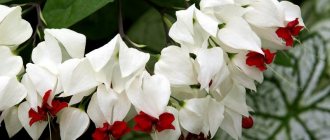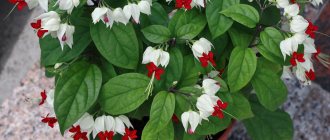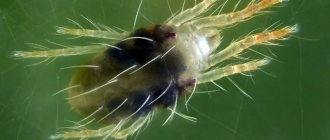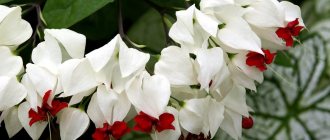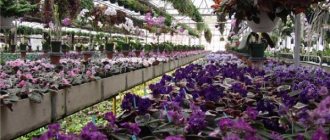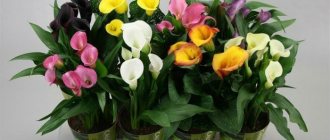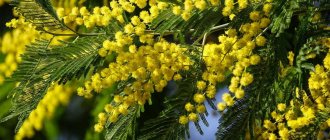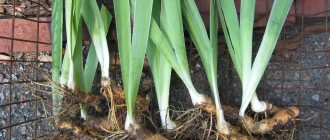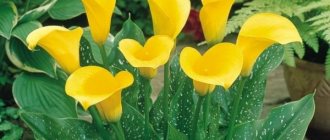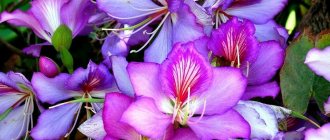Clerodendrum can rightfully be called one of the most unusual and original houseplants, surprising with its original flowers. The variety of their shapes and shades is amazing: blue, red, white, orange with simple or double petals, long or short stamens. The green part of the plant is no less impressive - large bright leaves are an excellent backdrop for magnificent inflorescences.
If you have blooming clerodendrum in your home, guests are guaranteed to be surprised. But it’s not at all easy to grow such beauty - among flower growers, this representative of indoor flora is considered very picky. However, enthusiastic lovers of house plants will not face any difficulties, and the result will certainly exceed all expectations.
In order to properly care for the plant, it is worth getting to know it better.
According to the botanical classification, clerodendrum (lat. Clerodendrum) is the common name of a genus belonging to the large family Lamiaceae. Everyone knows the closest relatives of clerodendrum - herbs (basil, mint, oregano, thyme, rosemary). More recently, the plant belonged to the Verbenovaceae family, but phytogenetic analyzes carried out in the 90s showed the fallacy of this classification.
The name has also changed: previously, clerodendrum was called volcameria. Subsequently, scientists found out that Volcameria is a separate botanical genus. The modern name of the magnificent handsome man is formed from two Greek words: “kleros” - fate, fate and “dendron” - tree. It was not by chance that clerodendrum was called the “tree of destiny” - the ancient Greeks used the plant for religious ceremonies in honor of the goddess Aphrodite and for medicinal purposes. And its modern popular names are “innocent love”, “crying heart”, “bloody cross” and “fluttering butterfly”.
[!] Those who believe in omens believe that clerodendrum brings happiness to girls and women. Well, more down-to-earth people note the pleasant, delicate smell of its flowers.
The homeland of clerodendrum is the tropical regions of South and Southeast Asia and Africa. Some species can be found in America, Australia and even in the south of our country.
At least three hundred species of clerodendrum are found in nature, but only a few of them are suitable for indoor growing.
What does clerodendrum look like and where does it come from?
Clerodendrum is a genus belonging to the Verbenaceae family. It has significant diversity. Among its more than 400 representatives there are trees, low shrubs, vines that shed their leaves for the winter and evergreen species.
Its homeland is tropical rainforests around the world. It is found in Southeast Asia, Oceania, Africa. Slightly less common in South and Central America.
The name of the plant is translated from Greek as “tree of fate.” This is due to the old belief that it can change your life for the better. It is not known exactly where the legend came from, but most consider the island of Java to be its homeland.
Where climate permits, clerodendrum is widely used in landscape design.
Flower growers sometimes, meaning clerodendrum, say “innocent love.” Perhaps this popular name is associated with the combined red and white flowers.
In nature, clerodendrum grows up to 3–5 m tall. But you can “shorten” it to a potted plant, up to about 1.5 m. Only regular formative pruning of the shoots will be required.
Most clerodendrums do not have a clearly defined stem. Instead, they have many shoots of approximately equal length and thickness that quickly become woody at the base. If there is still a trunk, it is most often hollow. In nature, ants will almost inevitably settle inside.
Clerodendrum leaves, depending on the type, are located opposite each other or in groups of three. Their shape is always heart-shaped, with a pointed tip. The length, depending on the type, is 7–15 cm. The surface of the leaf is dark green, uneven, and evokes associations with a quilt. “Bloats” are located between the veins. The edge can be either smooth or jagged. The leaves are thin to the touch, but dense and harsh.
Even non-flowering clerodendrum looks quite impressive
The main thing that attracts gardeners to clerodendrum is the flowers. In suitable conditions, the plant blooms very profusely, literally becoming covered with inflorescences in the form of a shield or panicle. Each inflorescence consists of 4–20 flowers. They are small (2–3 cm in diameter), but this is more than compensated by quantity.
In nature, the plant blooms from mid-spring to autumn. But at home, especially in winter gardens, greenhouses, greenhouses, you can achieve almost year-round flowering. Most species have a very special smell of flowers and leaves, characteristic only of this clerodendrum.
The fruit of the clerodendrum is similar to a berry, although from a botanical point of view it is a drupe. There are always 4 nests in it, in which 2–4 seeds ripen.
If you do not need clerodendrum seeds, cut off the faded inflorescences
A non-flowering plant can also be used in design. This is an excellent material for a trellis. It grows very quickly along guides (supports, wire), creating a continuous carpet of leaves.
History of selection
Under natural conditions, clerodendrum grows in Australia, Asia, Africa and Latin America in the form of shrubs or vines. Some species are presented in the form of trees that shed their leaves with the onset of the dormant period. This variety is found in:
- China;
- Korea;
- India;
- Japan;
- in the Philippines.
The flower originated in ancient Greece , but the peak of its popularity came in the mid-nineteenth century in European countries, when clerodendrum began to be actively grown in flower beds and greenhouses. A little later, the plant became the object of close attention of breeders, who developed a huge number of beautiful varieties by crossing different species.
We invite you to familiarize yourself with the description and rules for growing such varieties of clerodendrum as the sophisticated Prospero, the unpretentious Philippine, the amazing speciosum, the extraordinary most beautiful, the exotic brilliant, the amazing Bunge, the evergreen Ugandan, the fragrant Wallich and the bright Thompson.
The most beautiful and popular varieties grown at home
Of the many clerodendrums, 15–20 species are most often found in indoor floriculture.
Mrs. Thompson's clerodendrum (Thomsoniae)
This species is a climbing vine with shoots that quickly become woody at the base. The leaves are pubescent, with smooth edges. Sometimes the upper side of the leaf blade is covered with vague spots, darker or lighter than the main tone. Inflorescences in the form of panicles. Flowers with a white, cream or greenish calyx, similar to the “lantern” of physalis, and a scarlet corolla, which falls off before the calyx. In captivity it blooms in early spring, sometimes a second time in autumn. A variety with lime-colored leaves was developed. A superstition widespread on the islands of Oceania does not recommend growing this species for girls who want to get married. It is believed that the flower “attracts” loneliness to them.
Ms. Thompson's clerodendrum is the only one named after a woman
Brilliant or magnificent (splendens)
Low evergreen shrub with creeping shoots. The leaves are quite small, corrugated at the edges. Inflorescences are in the form of corymbs or short racemes, each with 30–40 flowers. They are very beautiful, dark pink, greenish calyx. The stamens are bright scarlet, curved.
The color of the petals of Clerodendrum brilliantis is known to artists as scarlet
Most beautiful (speciosissimum)
Also called prickly (fallax). An evergreen upright shrub, in nature it grows up to 3 m. A characteristic feature is tetrahedral-shaped shoots and reddish petioles of leaves covered with “lint”. It is short at the bottom and looks like wool, at the bottom it looks like fluff. The bush blooms all summer. Inflorescences in the form of panicles are located at the tops of the shoots. The outer calyx is purple-violet, the corolla is deep scarlet, almost the color of blood. Unlike most species, it does not have a dormant period.
Clerodendrum most beautiful is sometimes called Javanese due to its place of origin.
Fragrant (fragrans) or Philippine (philippinum)
Low (1.5–2 m) evergreen shrub with pubescent shoots and leaves. The edge of the leaf blade is highly serrated. Shield inflorescences are formed at the tips of the shoots. The pink-white flowers have a strong scent that intensifies in the evening and at night. It resembles a mix of violet, jasmine and orange blossom.
A distinctive feature of fragrant clerodendrum is its very long stamens.
Based on it, a hybrid was developed with double flowers that appear regardless of the time of year.
The terry variety of fragrant clerodendrum looks even more impressive
Paniculatum
Also known as Pagoda. Tree up to 12 m high. Suitable only for greenhouses and winter gardens. The characteristic bulges on the leaves are almost invisible, and the petioles are dull red. Flowers in inflorescences are arranged in clear tiers, evoking associations with pagoda roofs.
Due to its size, Clerodendrum paniculata is almost never grown in apartments.
Ugandan (ugandense)
A very fast-growing evergreen shrub with creeping shoots. The maximum height is 2 m. The inflorescence does not have a specific shape. Flowers with five petals look like butterflies. The top and sides are sky blue, the bottom resembles a boat and is slightly lilac. The long, outwardly curved stamens are pale blue. Flowering continues throughout the year with short interruptions. Even direct sunlight does not harm it. An additional advantage is easy reproduction.
The "blue butterflies" of Ugandan clerodendrum are worth trying to grow.
Video: description of Ugandan clerodendrum
Clerodendrum Wallichiana
Other names: Veil, Bridal Veil. The plant received its official name in honor of the Danish botanist and researcher of Indian flora Nicholas Wallich, who managed the Calcutta Botanical Garden for 25 years in the 19th century. In nature it is a bush, but with the help of pruning you can form a kind of tree about 0.5 m high. It blooms for 1.5–2 months starting from the end of summer. The calyx is greenish, the petals and stamens are snow-white. There is a breeding hybrid of it - clerodendrum Prospero, which differs from its parent in coral-orange cups.
The nickname of Clerodendrum Wallich is associated with the beautifully flowing clusters of inflorescences
Bungei
This variety is also called Bouquet of Kashmir. Under natural conditions, the shrub grows up to 3 m, at home - about half as much. The flowers are small, pastel pink.
From a distance, the spherical inflorescences of Clerodendrum Bunge are very reminiscent of hydrangea
Inerme or spineless (inerme)
An erect shrub up to 3 m high. The flowers are snow-white, with pale lilac stamens and pistil. There are 3 of them in each umbrella inflorescence.
Unlike other species, clerodendrum Inerme survives even in saline soil, for example, on the seashore
Indicum
Another name: Splash of champagne (sahelangii). In Russia it is still little known. The plant owes its unusual nickname to its small white flowers on long stalks, looking like drops scattering in different directions.
Due to its very successful nickname, the official name Clerodendrum indicum is almost never used
Clerodendrum Schmidtii (Schmidtii)
Also known as Chains of Glory. The edges of the leaves are slightly corrugated. The inflorescence is a very long (up to 50 cm), flowing raceme of small white flowers, reminiscent of a waterfall.
The flowers of Clerodendrum Schmidt, a tropical plant, persistently resemble snowflakes
Fireworks (quadriloculare)
The only one with burgundy leaves on the reverse side. The inflorescence is spherical, each flower is located on a long stalk. It blooms from the beginning of winter, for 2–3 months.
Clerodendrum fireworks inflorescence is a kind of hybrid of a sea urchin and a volley of fireworks
Musical notes
Another variant of the name of this variety is Morning Kiss (incisum Macrosiphon). Leaves with toothed edges. The flowers are white, with dark pink or crimson stamens. Flowering continues almost continuously.
Unopened clerodendrum buds Musical notes really look like quarter notes
Clerodendrum calamitosum
Compact low bush (0.6–0.75 m). Both petals and stamens are snow-white. It has a characteristic aroma that intensifies in the dark.
A distinctive feature of Clerodendrum calamitosum is its snow-white petals and stamens.
Video: types of clerodendrum
What kind of variety is Valichi, does it have any special features?
Reference. The Latin name of the plant is Clerodendrum wallichiana (“clero” - fate, “dendrum” - tree, so the plant is also called the “tree of fate”).
Different sources allow different variations of the name:
- Valici.
- Wallich.
- Wallich and so on.
The distinctive features of this type of clerodendrum are:
- Compactness - unlike Thompson's clerodendrum, this species is small in size and suitable for planting in flowerpots.
- Large snow-white inflorescences of small asymmetrical flowers with long stamens, exuding a pleasant fragrant aroma. For this feature, the plant is also called “bride’s veil” or “Cleopatra’s tears.” Due to the drooping shoots and the shape of the flower petals, the plant is also called “nodding jasmine”.
This type of clerodendrum is often called Prospero.
Check out the photo of the flower.
There are other, no less beautiful varieties of clerodendrum, including Ugandan, most beautiful, brilliant, speciosum, inerme, Philippine, Bunge and Thompson.
How to create optimal conditions?
Clerodendrum is a fairly hardy and unpretentious plant. But if you want to observe flowering regularly, take care of optimal conditions.
Table: optimal conditions
| Factor | Optimal conditions |
| Location | A window sill facing east or west is suitable. If it faces north, the clerodendrum will not die, but it will not bloom. When placing a flower on a south-facing window, think about how you will protect it from the hot sun. |
| Lighting | Any clerodendrum needs bright but diffuse sunlight for 8–10 hours daily. In winter, use fluorescent lamps as additional lighting. |
| Temperature | In the intensive growth phase (early spring-mid-autumn), the optimal temperature is 20–25ºС. During the rest period it is reduced to 16–18ºС. The flower will survive at 10–12ºС, but this is the limit. If there is no suitable room where you can put the plant away for the winter, place it as close to the window glass as possible. Avoid sudden changes in temperature. |
| Air humidity | Clerodendrum reacts negatively to dry air. To achieve a humidity level of 75–80%, spray the flower daily with water at room temperature (2–3 times a day in summer), remove it as far as possible from working radiators. If the indicator drops below 45–50%, place wet moss, peat, or expanded clay in the pan. |
| Availability of support | The presence or absence of support depends solely on how you want the clerodendrum to look. If you want to get a continuous carpet of greenery or a long vine, send shoots along wire or thin twine. To form a more compact plant, use a ring-shaped support and wrap the shoots around it. |
Support option for clerodendrum
Possible difficulties
Home clerodendrum, although unpretentious, still prefers a comfortable microclimate. The room where inerme is grown should be quite warm - from 18 to 25 degrees, and in winter - from 15 to 18. Clerodendrum does not tolerate drafts, so it is better to carefully monitor this.
Although the flower loves warmth, the pot cannot be placed near heating pipes and radiators . During the winter dormancy period, the temperature in the room should be quite cool: no higher than 15 degrees.
In addition to difficulties with caring for the plant, difficulties may arise in the form of uninvited guests, from which remedies such as:
- "Bona Forte".
- "Aktaroy".
- "Aktellikom".
Clerodendrum instantly wins the hearts of gardeners with its flowering, so it is difficult to resist the temptation to have such beauty at home. If you give the plant a few minutes a day, it will delight you with its magical blooms for a long time. And proper care during the dormant period will allow you to enjoy flowering all year round.
Transplant procedure
The optimal time for replanting clerodendrum is early spring, when the flower “wakes up” after a dormant period. Plants under the age of 5 years are replanted annually, each time increasing the diameter of the pot by 2–3 cm. For adult clerodendrums, one transplant every 3–5 years is sufficient.
Simultaneously with replanting, it is advisable to cut each shoot by a third to make the flower more decorative and bushy.
If you purchased clerodendrum in a store, give it 10–15 days to get used to the new environment, then replant. The universal soil used by indoor plant growers does not take into account the specific needs of the flower.
The pot should have a large drainage hole. Place a layer of drainage (expanded clay, pebbles, crushed stone, brick chips, ceramic shards) 3–4 cm thick at the bottom.
Ready-made soil can be purchased in specialized stores. Look for one that is designed for roses and azaleas. They need to be mixed in a 4:1 ratio.
When preparing it yourself, remember that clerodendrum prefers slightly acidic soils, light and breathable. When collecting soil from your own garden, check the acidity level. The soil mixture may look like this:
- Fertile turf, ordinary soil, dry peat, coarse river sand, humus in equal proportions.
- Leaf soil, powder clay, coarse sand, dry peat. The first component needs to be taken twice as much as the others.
The fragile roots of clerodendrum should never be disturbed during transplantation. It is strictly forbidden to shake off the soil from them and/or rinse them with running water. The entire ball of earth is removed from the pot and placed on a layer of substrate in a new pot. The prepared soil is added to the edges and compacted. The transplantation method is known as transshipment.
The support (if needed) is placed in the pot at the same time as the earthen ball, and not stuck in later. Otherwise, there is a high risk of injuring the roots.
Clerodendrum: plant description
Clerodendrum flower: plant photo
The plants are native to West Africa. Belongs to the verbena family, otherwise it is called Clerodendrum.
In general, the Clerodendrum plant is a flowering vine, and a very beautiful one at that. In total there are about four hundred varieties of Volkameria.
Clerodendrum is an amazing plant; it has a unique feature - fast growth. Most of the varieties are distinguished by oval or round leaves and incomparably beautiful flowers, which are collected in inflorescences.
Necessary care
Clerodendrum vitally needs only abundant watering. If you want to make the plant more decorative and tidy, annual formative pruning is necessary.
Watering
During the active growth phase, water the clerodendrum abundantly every 3-4 days and spray the leaves daily with soft water at room temperature, which has stood for at least a day. The plant is especially demanding of moisture during flowering. Ideally, you need to use rain or melt water, but not everyone has this opportunity. Tap water can be softened by adding 3-4 granules of citric acid to a 10-liter bucket and waiting for sediment to settle.
But it is also undesirable to create a swamp in a pot. After watering, wait 15–20 minutes and drain excess water from the pan. This way you will gradually decide on the norm.
Clerodendrum that lacks moisture can be easily identified by its drooping leaves.
Top dressing
Fertilizers are applied only at the active growth stage every 12–15 days. The first fertilizing is carried out immediately after transplantation, associated with pruning. After flowering, clerodendrum does not need fertilizer until next spring.
The flower accepts both organic matter and store-bought liquid fertilizers for flowering indoor plants (especially those with high concentrations of phosphorus). If possible, alternate them.
Natural organic matter is an infusion of fresh cow manure or bird droppings. It is best to cook it outside of your apartment. Even with the lid tightly closed, the smell is very specific. The selected container is filled about a third with raw materials and topped up with water. Then close tightly. After 3–4 days, after the characteristic odor appears, the contents are vigorously mixed. For irrigation, the fertilizer is diluted with water in a ratio of 1:15.
If you notice that the leaves are turning pale, becoming translucent, spray the underside with a solution of complex mineral fertilizer.
Bloom
Clerodendrum blooms profusely and almost continuously from May to October. If you want to receive flowers by a certain date, try to “deceive” the plant. Put it in the darkest corner of the room, stop fertilizing, spraying and reduce watering. After 20–25 days, the lower leaves will droop, turn yellow and fall off, but buds will form on the tops of the side shoots in the leaf axils. Wait for this moment and return the plant to its original place, providing it with optimal conditions.
Rest period
Most varieties of clerodendrum require a dormant period. This is a necessary condition for flowering next year.
After the plant has finished flowering, stop feeding and gradually reduce watering. When the lower leaves begin to fall off, move it to a bright, cool (15–18ºС) room.
Clerodendrum cannot do without water at all, even in winter. One watering every 3-5 days is enough. The norm is approximately halved compared to summer. Do not bring the flower to such a state when the soil begins to move away from the edges of the pot. In this case, immediately water the plant outside of the schedule.
Pruning: how to shape a bush, tree and other options
Pruning is a necessary procedure for clerodendrum. Otherwise, it will look very sloppy, take up the entire window sill, and also hang down.
Long vine shoots provide gardeners with a wide range of possibilities for giving the plant a wide variety of shapes. The easiest option is to send the shoots up along guides (thin wire or twine) tied to a curtain rod or fixed to the ceiling. Soon you will have a solid green wall. An alternative option is hanging flowerpots. Then you can do without tying. Every year, the shoots need to be cut back by about a third, while at the same time getting rid of dried, broken, dead lashes. This way you stimulate the flower to form new shoots.
If you want to form a bush from clerodendrum, cut all shoots to 50 cm every year. Pinch the tops of young shoots from last year by a quarter at the same time. Ideally, the shape should be close to spherical.
You can give clerodendrum the appearance of a tree, justifying its name. Select 2–3 most developed shoots, cut them to a height of 60–70 cm. Cut the side branches on them by half. At the bottom, to a height of 10–15 cm, cut off all the greenery on the main shoots, leaving bare trunks. In the future, annually pinch out young shoots by 8–10 cm, and remove all growth at the roots.
Using pruning, you can bring any variety of clerodendrum to an acceptable size.
Perform pruning only with sharp, disinfected scissors to avoid damaging the shoots and causing infection.
Video: caring for Mrs. Thompson's clerodendrum
Varieties: photos and descriptions
Brilliant
It is called brilliant for its bright “varnish” leaves. In nature, the species is distributed in the mountains of Southern China, India and Nepal.
This species also has lush snow-white blooms and blooms at any time of the year.
In autumn there is abundant flowering. Its leaves are bright green. On the peduncles there are white flowers, which are collected in inflorescences. The flowering cycle lasts about two months. The peculiarity of this flower is its long stamens.
Philippine
Volkameria fragrant usually reaches two meters in height. The size of the leaves varies around 12-16 centimeters. The leaves have a gray-green tint, and their structure is velvety.
The main distinguishing feature is flowering. The flowers are pinkish-white. Since they are located close to each other, it seems that this is one whole flower.
The main feature of Clerodendrum Philippine is its ability to bloom all year round.
Thompson
The growth rate is very high. The branch is thin and smooth. Over the years, the vine becomes covered with tree bark. The bunches of inflorescences are heart-shaped and white. The leaves are bright green, pointed at the tips.
In indoor conditions, Clerodendrum Thompson grows quite quickly.
It blooms in spring. The plant prefers frequent watering and moist air.
You can learn more about the peculiarities of keeping Thompson's clerodendrum, and also see a photo of the flower here.
Beautiful
A species that grows on the African continent. In the wild, its size ranges from 2.5 to 3 meters, but in your home this plant will grow to a maximum of 1 meter. The flowers are whimsical and bright red in color.
This type is significantly different from others, as it has a non-standard shape. The stamens of Clerodendrum most beautiful protrude outward. The peculiarity of this plant is its long flowering - throughout the summer and autumn.
Variegated
Variegated, like others, is an evergreen species. The stamens of the flower are purple, and the petals are pale white. Loves the sun's rays, rather unpretentious to the soil.
Feels great on the sea coast, without being afraid of the heat and sea spray. This plant easily tolerates pruning and quickly forms new shoots.
To successfully grow such an amazing plant as clerodendrum, read our materials about its other types and varieties: Speciosum, Bunge, Ugandan, Prospero or Wallich.
Common mistakes gardeners make
Clerodendrum, of course, is undemanding, but mistakes by inexperienced gardeners often negatively affect the decorativeness of the plant.
Table: frequently asked questions when growing clerodendrum
| Problem | Most Likely Cause |
| Individual areas of the leaves lighten, then dry out and die. | The plant was exposed to direct sunlight and suffered burns. If it is located on a south-facing window, try to water it so that the drops do not fall on the leaves. They act as lenses, focusing the rays. |
| The shoots become thinner and stretch out. The distance between the leaves increases, they become smaller. | Clerodendrum lacks light and/or nutrition. |
| The leaves wither, turn yellow, fall off, the buds dry out without blooming. | If only the lower leaves fall, and this happens in winter, the situation is normal. Otherwise, you are not watering the plant enough. |
| Light spots of irregular shape on the leaves. | The room temperature is too low and/or there are cold drafts. |
| Lack of flowering. | Clerodendrum was not provided with a period of rest of sufficient duration in compliance with all conditions. Another option is a lack or, conversely, an excess of nutrients in the soil. The latter can be determined by the increased size and darkened leaves. |
Diseases and pests
Clerodendrum has excellent immunity , so it very rarely suffers from fungal diseases.
And if the plant gets sick, then this is most likely the consequences of improper care, and not an infectious disease, so it is necessary to correct all violations in the maintenance of the flower.
Common problems and how to fix them
- The leaves turn yellow and wither. The reason for this phenomenon is insufficient watering. In this case, it is necessary to carefully get rid of the yellowed foliage and transfer the flower to a regular moisture regime.
- Leaves and buds dry out and fall off. The reason is excessive dry air in the room. To eliminate the disease, you need to spray the plant more often and use humidifiers.
- Large distance between two adjacent internodes. The reason is insufficient lighting. In this case, the plant should be placed closer to the sun, or a phytolamp should be used.
- Long absence of flowering. This may be due to improper organization of the rest period, or due to unbalanced feeding. Replanting into a fresh substrate and obligatory dormancy during wintering will help return the crop to flowering: from the second half of October, the flower is transferred to a cooler room, and watering is reduced.
- The appearance of yellowness and change in leaf shape. These signs indicate the presence of chlorosis, which is the result of some trace element in the soil. This disease is not fatal, and it can be cured with a complex of mineral fertilizers.
- Powdery mildew is a common sign that a flower has been watered with cold water. Therefore, to moisturize, you need to use liquid at strictly room temperature!
As for parasites, clerodendrum is most often attacked by:
- whiteflies;
- scale insects;
- spider mite.
The reason for their appearance is too dry air.
Tip: You can completely get rid of insects using modern insecticides.
Treat the room in two or three passes with a break between them for a week.
Pest Control
Inspect plants regularly for signs of damage and take appropriate action immediately.
Table: the most common pests of clerodendrum
| Pest | Symptoms | Fighting methods | Prevention |
| Spider mite | The pest gnaws through the leaf and sucks out the juice. The underside of the leaf blade is covered with tiny white dots. The leaves and shoots are intertwined with thin, almost transparent threads, similar to a cobweb. In particularly advanced cases, the plant is almost invisible under a dense layer of whitish mass; many pests accumulate on the tops of the shoots. |
| High humidity is detrimental to spider mites. It is useful to give the plant a warm shower every 20–25 days. First, apply a thick foam of laundry soap to the leaves and shoots for 15–20 minutes. |
| Mealybug | The pest is easy to recognize by the small dirty white pellets that appear on the leaves and roots, similar to cotton wool. At the same time, cloudy drops appear on the underside of the leaves. The flower stops growing and the leaves fall off. |
| Proper care. |
| Whitefly | Small flying insects suck sap from plants. Shake the flower and you will find swarms of pests rising into the air. |
| It has been noticed that whiteflies are very attracted to the yellow color. You can make your own trap from a sheet of paper and cardboard by applying glue, Vaseline, or something else sticky to it. |
| Shchitovka | Grayish-brown plaques appear on shoots and leaves. These are the shells of pests that suck the sap of the plant. At the same time, the presence of sticky transparent discharge is characteristic. |
| Proper care. Scale insects will not appear in high humidity and bright light. |
Many acaricides are toxic, so it is best to carry out treatment outdoors.
Photo gallery: clerodendrum pests
Not just any insecticide can “dissolve” the durable shell of the scale insect.
Whiteflies are easy to identify, but quite difficult to get rid of.
Certain varieties of mealybug attack the roots. The pest is difficult to identify until it is too late
To combat spider mites, use special preparations - acaricides
Reproduction methods
Clerodendrum, like most indoor plants, propagates by seeds (generatively) and cuttings (vegetatively).
Rooting cuttings
Clerodendrum cuttings quickly take root even in plain water
The easiest way to grow a new clerodendrum is to take a cutting from an old one.
Apical cuttings 8–10 cm long with 2–3 leaves are cut off in early spring and the lower third is dipped in a solution of a root formation stimulator - Epin, Kornevin, Topaz, potassium humate. After a day, the cuttings need to be rooted into individual pots with a diameter of 7–9 cm in a mixture of sand and peat or humus in equal proportions.
It is best to root the tops of clerodendrum shoots
To create a greenhouse effect, the pots are covered with plastic bags or glass jars. Cuttings need plenty of watering and bright light. Once new leaves appear, gradually acclimate them to their environment.
After 4–5 months, transplant the clerodendrums into soil for adult plants, pinching the shoots by a quarter. Care as usual.
Young clerodendrums will bloom this year
Germination of seeds
Clerodendrum seeds are definitely among the ten most unusual indoor plants
Clerodendrum seeds ripen at the end of winter. They are planted in early spring in a mixture of fertile turf soil (or humus), dry peat and sand in equal proportions. The containers are covered with glass or film, maintaining a constant temperature of about 22ºC and high humidity. Once a day, planting is ventilated for 3–5 minutes. You will have to wait a long time for germination: 45–60 days.
Clerodendrum seeds take a long time to germinate
When 3–4 true leaves appear, the seedlings are planted in separate pots and cared for as if they were rooted cuttings. They will bloom next year.
